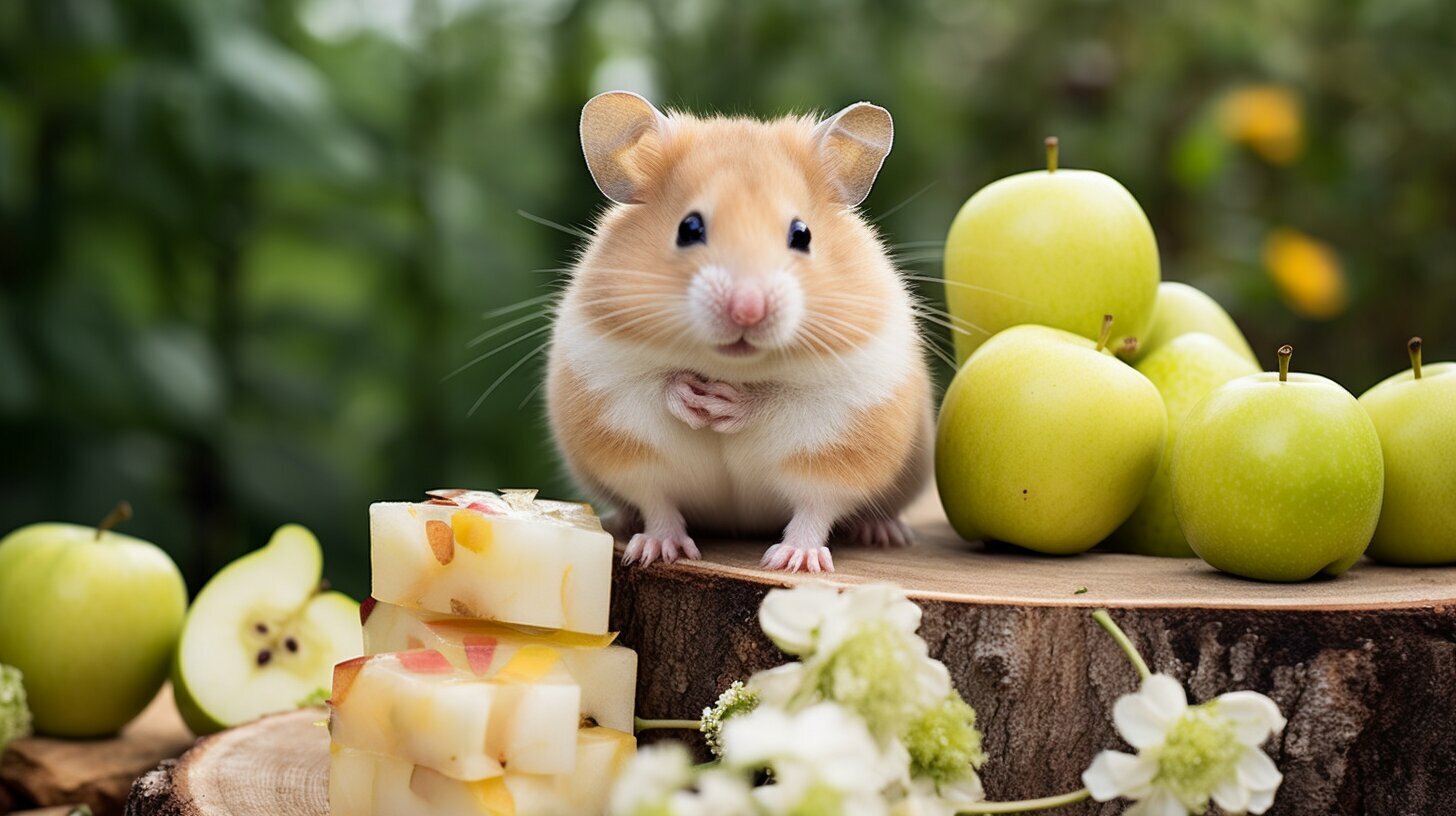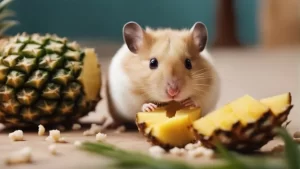Hamsters have specific dietary needs, and as a responsible pet owner, you may be wondering, can hamsters eat pears?
Pears are a delicious and nutritious fruit that many of us enjoy, but is it safe to share them with your furry friend? While hamsters can eat pears, it’s important to understand the guidelines and precautions to ensure their health and well-being.
Key Takeaways:
- Hamsters can eat pears, but only in small amounts and not every day.
- Pears provide nutritional benefits such as dietary fiber, Vitamin C, and antioxidants.
- Too much pear can lead to digestive issues, diabetes, and obesity in hamsters.
- Feeding guidelines vary for different hamster species, with Syrian and Roborovski hamsters able to have a small slice of pear once or twice a week, and dwarf hamsters able to have a small piece once every two weeks.
- Remove pear seeds before feeding them to hamsters and clean out any uneaten pieces to prevent rotting in the cage.
- In small amounts, dried pears can also be given to hamsters.
- As with any food, it is best to maintain a balanced diet for hamsters, including high-quality hamster food and occasional fruits and vegetables.
Understanding Hamster Nutrition
Before diving into specifics about feeding pears to hamsters, it’s crucial to understand their overall nutritional requirements. Hamsters are omnivorous creatures that need a balanced diet to thrive. While their primary diet consists of high-quality hamster food, incorporating occasional fruits and vegetables can provide added nutritional benefits.
When it comes to fruits like pears, moderation is key. Pears are a healthy treat for hamsters due to their nutritional content. They contain dietary fiber, which aids in digestion, and Vitamin C, which boosts the immune system. They also provide antioxidants that help protect the hamster’s body against damage from harmful molecules known as free radicals.
However, it’s important to note that hamsters have small digestive systems and sensitive stomachs. Feeding them large amounts of pears or any other fruit can lead to digestive issues such as diarrhea or upset stomach. Excessive fruit consumption can also contribute to diabetes and obesity in hamsters. Therefore, pears should only be given in small amounts and not on a daily basis.
The specific feeding guidelines for hamsters vary depending on the species. For Syrian and Roborovski hamsters, a small slice of pear once or twice a week is sufficient. Dwarf hamsters, on the other hand, can have a small piece of pear once every two weeks. It’s crucial to remove the seeds from the pear before offering it to your hamster, as they can be a choking hazard. Additionally, any uneaten pieces of pear should be promptly removed from the cage to prevent rotting and potential health issues.
Table: Feeding Guidelines for Hamster Species
| Hamster Species | Feeding Frequency | Portion Size |
|---|---|---|
| Syrian Hamsters | Once or twice a week | Small slice |
| Roborovski Hamsters | Once or twice a week | Small slice |
| Dwarf Hamsters | Once every two weeks | Small piece |
Furthermore, dried pears can be given to hamsters as a tasty and nutritious snack. However, like fresh pears, they should be offered in small amounts due to their concentrated sweetness. It’s essential to monitor your hamster’s consumption and ensure they maintain a balanced diet overall.
In conclusion, pears can be a healthy addition to a hamster’s diet when fed in moderation. They offer dietary fiber, Vitamin C, and antioxidants, which promote a strong immune system and digestive health. Remember to follow the feeding guidelines specific to your hamster’s species, and always prioritize the overall balanced nutrition that high-quality hamster food provides.
The Benefits of Pears for Hamsters
Pears offer several health benefits for your hamster, making them a potentially nutritious treat option. These juicy fruits are packed with dietary fiber, which can aid in maintaining a healthy digestive system. Fiber also helps prevent constipation in hamsters, ensuring that their bowel movements stay regular.
In addition to fiber, pears are a good source of Vitamin C. This essential nutrient supports the immune system and helps hamsters fight off infections and diseases. Vitamin C also aids in the absorption of iron, promoting healthy blood circulation in your furry friend.
Pears also contain antioxidants, which help protect hamsters’ cells from damage caused by free radicals. These harmful molecules can contribute to aging and the development of certain diseases. By including pears in your hamster’s diet, you can help reduce the risk of oxidative stress and keep your pet healthier overall.
| Benefits of Pears for Hamsters | Guidelines for Feeding Pears |
|---|---|
| 1. Provides dietary fiber for a healthy digestive system | Remove seeds and clean uneaten pieces |
| 2. Supplies Vitamin C for a strong immune system | Feed small amounts, once or twice a week for Syrian and Roborovski hamsters |
| 3. Offers antioxidants to protect cells from damage | Feed small pieces, once every two weeks for dwarf hamsters |
While pears are beneficial for hamsters, it is important to exercise caution when feeding them. Hamsters should only have small amounts of pear as a treat, as too much can lead to digestive issues, diabetes, and obesity. Always remember to remove the seeds before giving your furry friend a slice of pear, as they can be harmful if ingested. Additionally, clean out any uneaten pear pieces from the cage to prevent rotting and maintain a hygienic environment.
If you prefer, you can also offer dried pears as a treat option for your hamster. However, it is important to note that dried fruits are more concentrated and should be given in even smaller amounts to avoid excessive sugar intake. As with fresh pears, clean out any uneaten dried pear pieces from the cage to prevent spoilage.
Feeding Guidelines for Different Hamster Species
Different species of hamsters have varying dietary needs, and their ability to consume pears may differ as well. While pears can provide nutritional benefits to hamsters, it is important to follow specific feeding guidelines to ensure their health and well-being.
Syrian and Roborovski Hamsters:
For Syrian and Roborovski hamsters, who have a larger body size and higher metabolic rate, a small slice of pear can be given as a treat once or twice a week. This allows them to enjoy the nutritional benefits of pears without overloading their system with excess sugar. It is crucial to remove any seeds from the pear slice before offering it to these hamsters, as seeds can pose a choking hazard.
Dwarf Hamsters:
Dwarf hamsters, including Campbell’s, Winter White, and Roborovski dwarfs, have smaller bodies and slower metabolisms. As a result, they can have a small piece of pear once every two weeks. It is important to monitor their intake and not exceed this frequency, as too much pear can lead to digestive issues.
Regardless of the hamster species, it is essential to clean out any uneaten pear pieces promptly. Leaving them in the cage can cause rotting and attract pests. Additionally, it is recommended to offer a varied and balanced diet to hamsters, consisting mostly of high-quality hamster food and occasional fruits and vegetables, including pears.
| Hamster Species | Feeding Frequency |
|---|---|
| Syrian and Roborovski Hamsters | Once or twice a week |
| Dwarf Hamsters | Once every two weeks |
Note: Always consult with a veterinarian or knowledgeable pet expert to ensure you are providing the best diet for your specific hamster species. Dietary needs can vary, and individual hamsters may have specific health concerns that require tailored feeding plans.
Can Syrian and Roborovski Hamsters Eat Pears?
If you own a Syrian or Roborovski hamster, you might be wondering if pears can be a part of their diet. The answer is yes, but moderation is key. Pears can provide nutritional benefits for these hamster species, but they should be offered in small amounts and not every day.
Syrian and Roborovski hamsters can have a small slice of pear once or twice a week. This frequency ensures that they receive the nutritional advantages of pears without overindulging. Remember that hamsters are small creatures, and their digestive systems are sensitive. Feeding them too much pear can lead to digestive issues, diabetes, and obesity.
It is also essential to remove the seeds from the pear before offering it to your hamster. Pear seeds contain trace amounts of cyanide, which can be harmful to their health. Additionally, be sure to clean out any uneaten pieces of pear from their cage promptly. Leaving fruit in the cage can cause it to rot and potentially harm your hamster.
If you prefer, you can also give dried pears to your Syrian or Roborovski hamster as a treat. However, it is crucial to provide them in small amounts due to the concentrated sugar content of dried fruits. A small piece of dried pear once in a while can be a delightful snack for your furry friend.
In conclusion, while pears can be included in the diet of Syrian and Roborovski hamsters, it is best to offer them in moderation and follow the recommended feeding guidelines. Remember to remove seeds and clean out any uneaten pieces to keep your hamster healthy and happy. Maintaining a balanced diet, including high-quality hamster food and occasional fruits and vegetables, is essential for the overall well-being of your pet.
| Species | Frequency of Pear | Portion Size |
|---|---|---|
| Syrian Hamster | Once or twice a week | Small slice |
| Roborovski Hamster | Once or twice a week | Small slice |
Can Dwarf Hamsters Eat Pears?
Dwarf hamsters have unique dietary requirements, and you may be curious about whether pears are safe for them to consume. The good news is that yes, dwarf hamsters can eat pears, but it’s important to do so in moderation. Pears can be a healthy and tasty treat for your furry friend, but too much can lead to health problems.
When feeding pears to dwarf hamsters, it’s important to follow the recommended guidelines. A small piece of pear once every two weeks is typically sufficient for dwarf hamsters. Remember, their stomachs are small, so a little goes a long way. It’s best to offer a small slice or cube of pear to avoid overwhelming their digestive system.
While pears are safe for dwarf hamsters, there are a few precautions to keep in mind. Make sure to remove the seeds from the pear before offering it to your hamster, as they can be a choking hazard. Additionally, always monitor your hamster’s consumption and remove any uneaten pieces of pear to prevent them from spoiling in the cage.
| Feeding Guidelines for Dwarf Hamsters and Pears | |
|---|---|
| Frequency | Once every two weeks |
| Portion Size | Small slice or cube |
| Precautions | Remove seeds and clean uneaten pieces |
In addition to pears, it’s crucial to maintain a balanced diet for your dwarf hamster. High-quality hamster food should make up the majority of their diet, with occasional fruits and vegetables as treats. Remember, variety is key, so offer a range of nutritious foods to keep your hamster healthy and happy.
By following these guidelines and offering pears in moderation, you can safely incorporate this tasty fruit into your dwarf hamster’s diet. Just remember to prioritize their overall nutritional needs and always consult with a veterinarian if you have any concerns or questions about your hamster’s dietary requirements.
Precautions When Feeding Pears to Hamsters
While pears can be a healthy treat for hamsters, it’s important to take certain precautions to ensure their safety and well-being. Hamsters have sensitive digestive systems, and improper feeding of pears can lead to digestive issues and other health problems.
Firstly, always remember to remove the pear seeds before offering the fruit to your hamster. Pear seeds contain trace amounts of cyanide, which can be toxic to small animals like hamsters. Additionally, the seeds can present a choking hazard.
Secondly, it’s essential to clean out any uneaten pieces of pear from your hamster’s cage. Pears, like other fruits, can quickly spoil and attract bacteria or flies if left uneaten. Regularly check the cage for any leftover pieces and discard them promptly to maintain a clean and healthy environment for your furry friend.
Lastly, moderation is key when it comes to feeding pears to hamsters. While they can enjoy the occasional slice or piece, feeding too much pear can lead to health issues such as diabetes and obesity. Consult with a veterinarian or a hamster nutritionist to determine the appropriate portion size and frequency of serving pears based on your hamster’s specific needs and dietary requirements.
| Precautions for Feeding Pears to Hamsters | |
|---|---|
| 1 | Remove pear seeds to prevent potential toxicity and choking hazards. |
| 2 | Regularly clean out any uneaten pieces of pear from your hamster’s cage to prevent spoilage and bacterial growth. |
| 3 | Feed pears in moderation to prevent digestive issues, diabetes, and obesity. |
By following these precautions, you can safely incorporate pears into your hamster’s diet as a healthy and nutritious treat. Remember, it’s essential to prioritize your hamster’s overall well-being and consult with professionals for expert guidance on their specific dietary needs.
Dried Pears for Hamsters
If you’re considering offering dried pears as a treat, here’s what you need to know about feeding them to your hamster. Dried pears can be a tasty and nutritious addition to your hamster’s diet, but it’s important to offer them in moderation and with caution.
Dried pears provide a concentrated source of nutrients for hamsters, including dietary fiber, vitamins, and minerals. They can be a great alternative to fresh pears if you don’t have access to them or want to provide a longer-lasting treat for your furry friend.
Feeding Guidelines:
When offering dried pears to your hamster, keep in mind the following guidelines:
- Offer a small piece of dried pear as an occasional treat, no more than once or twice a week.
- Ensure the dried pears are unsweetened and free from any additives or preservatives.
- Always remove the seeds from the dried pears before feeding them to your hamster. The seeds can be a choking hazard and contain potentially harmful compounds.
Remember to monitor your hamster’s response to dried pears and adjust the portion size accordingly. Too much dried fruit can have adverse effects on your hamster’s health, including digestive issues and weight gain.
It’s essential to maintain a balanced diet for your hamster, which includes high-quality hamster food as the main source of nutrition. Dried pears should only be offered as an occasional treat to supplement their diet and provide variety.
| Dried Pears Feeding Guidelines | |
|---|---|
| Feeding Frequency | Once or twice a week |
| Portion Size | Small piece |
| Preparation | Remove seeds |
By following these feeding guidelines and considering your hamster’s individual needs, you can safely incorporate dried pears into their diet as a delicious and nutritious treat. Remember, moderation is key when it comes to offering any type of treat to your pet.
Maintaining a Balanced Hamster Diet
While pears can be a part of your hamster’s diet, it’s essential to ensure they receive a balanced and nutritious overall meal plan. Hamsters have specific dietary requirements, and providing them with a variety of foods is crucial for their health and well-being. In addition to high-quality hamster food, incorporating occasional fruits and vegetables, such as pears, can be beneficial.
Benefits of a Balanced Hamster Diet:
A balanced hamster diet that includes pears offers several advantages. Pears are a good source of dietary fiber, which aids in proper digestion and helps prevent constipation. They also contain Vitamin C, an essential nutrient for hamsters that promotes a healthy immune system. Additionally, pears are rich in antioxidants, which can help prevent cell damage and improve overall health.
| Hamster Species | Feeding Guidelines for Pears |
|---|---|
| Syrian Hamsters | Small slice of pear once or twice a week |
| Roborovski Hamsters | Small slice of pear once or twice a week |
| Dwarf Hamsters | Small piece of pear once every two weeks |
Important Considerations:
When feeding pears to your hamster, it is crucial to remove the seeds as they can be a choking hazard. Additionally, any uneaten pieces of pear should be promptly removed from the cage to prevent them from rotting. It’s essential to monitor your hamster’s response to pears and ensure they do not consume excessive amounts, as this can lead to digestive issues, diabetes, and obesity. Dried pears can also be given to hamsters as an occasional treat, but in small amounts.
Summing It Up
Providing your hamster with a balanced diet is key to their overall health and well-being. While pears can be included as part of their diet, it’s important to follow specific feeding guidelines for different hamster species and monitor their intake. A balanced hamster diet, consisting of high-quality hamster food and occasional fruits and vegetables like pears, ensures that your furry friend receives the necessary nutrients for a happy and healthy life.
Conclusion
Feeding pears to your hamster can be a safe and nutritious addition to their diet, as long as it is done in moderation and following the appropriate guidelines. Pears offer valuable nutrition for hamsters, including dietary fiber, Vitamin C, and antioxidants. However, it is essential to remember that hamsters have specific feeding requirements, and pears should only be given in small amounts.
Different species of hamsters have varying tolerances for pears, so it is important to follow the recommended guidelines. Syrian and Roborovski hamsters can enjoy a small slice of pear once or twice a week, while dwarf hamsters can have a small piece every two weeks. These portions ensure that your hamster receives the nutritional benefits of pears without overloading their digestive system.
When feeding pears to your hamster, always remember to remove the seeds. Pear seeds can be a choking hazard and should never be given to hamsters. Additionally, clean out any uneaten pieces to prevent them from rotting in your hamster’s cage. Proper precautions such as these will help keep your hamster healthy and happy.
In addition to fresh pears, dried pears can also be given to hamsters in small amounts. However, it is important to remember that dried fruits are more concentrated in sugars, so moderation is key.
Ultimately, maintaining a balanced hamster diet is crucial for their overall well-being. High-quality hamster food should always be their primary source of nutrition, supplemented with occasional fruits and vegetables, including pears. By following the appropriate feeding guidelines and taking necessary precautions, you can ensure that your hamster enjoys the benefits of pears as part of a healthy and balanced diet.
FAQ
Q: Can hamsters eat pears?
A: Yes, hamsters can eat pears, but only in small amounts and not every day.
Q: What are the benefits of pears for hamsters?
A: Pears are nutritious and provide dietary fiber, Vitamin C, and antioxidants for hamsters.
Q: Do different hamster species have different feeding guidelines for pears?
A: Yes, different hamster species have different feeding guidelines. Syrian and Roborovski hamsters can have a small slice of pear once or twice a week, while dwarf hamsters can have a small piece once every two weeks.
Q: Should pear seeds be removed before feeding them to hamsters?
A: Yes, it is important to remove pear seeds before feeding them to hamsters.
Q: Can dried pears be given to hamsters?
A: Yes, dried pears can be given to hamsters in small amounts.
Q: What precautions should be taken when feeding pears to hamsters?
A: Precautions include removing seeds and cleaning out any uneaten pieces to prevent rotting in the cage.
Q: Should pears be a regular part of a hamster’s diet?
A: No, it is best to maintain a balanced diet for hamsters, including high-quality hamster food and occasional fruits and vegetables.




